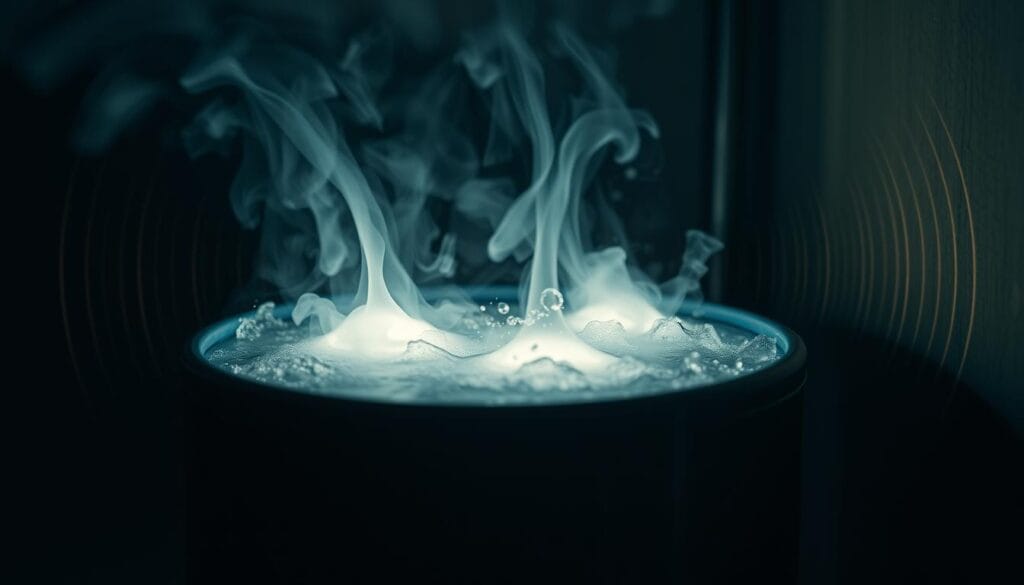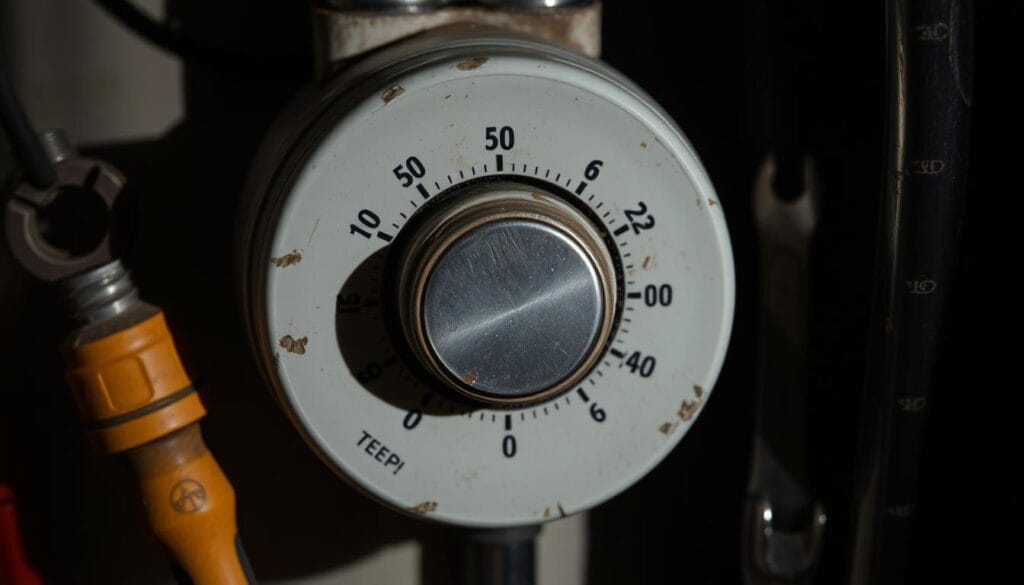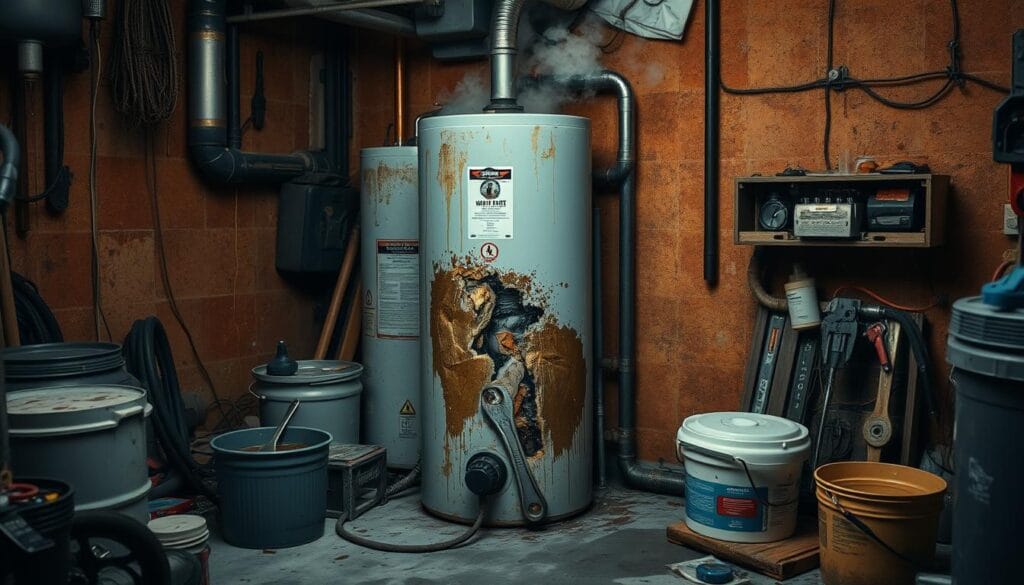Water heaters are key in any home, giving us hot water for showers, washing dishes, and laundry. But, they can face many issues like no hot water, bad smells, limescale, leaks, and uneven temperatures. Knowing about these problems and how to fix them can help keep your water heater working well for longer.
Key Takeaways
- Water heater issues can significantly impact home comfort and convenience.
- Common problems include insufficient hot water, noisy operation, leaks, and water temperature fluctuations.
- Sediment buildup, heating element failures, and plumbing connection issues are leading causes of water heater problems.
- Routine maintenance, such as annual flushing and thermostat adjustments, can help prevent many water heater issues.
- Consulting a professional plumber is recommended for complex problems or situations requiring advanced troubleshooting or repairs.
Understanding Your Water Heater System
Knowing about your home’s water heater is key. It helps ensure it works well and lasts long. Let’s explore the basics.
Types of Water Heaters
There are many water heaters out there. Each has its own benefits. Here are a few common ones:
- Electric water heaters
- Gas-powered water heaters
- Hybrid heat pump water heaters
Basic Components and Functions
All water heaters have similar parts. These include heating elements, thermostats, and pressure relief valves. They work together to heat water and keep it at the right temperature. This ensures you always have hot water when you need it.
Importance of Regular Maintenance
Keeping your water heater in good shape is vital. Regular checks and maintenance can prevent problems. This includes flushing the tank, replacing the anode rod, and checking the pressure relief valve. These steps help avoid issues like sediment buildup and corrosion. They also make your water heater last longer and work better.
| Maintenance Task | Frequency | Benefits |
|---|---|---|
| Tank Flushing | Annually | Removes sediment buildup, improves efficiency |
| Anode Rod Replacement | Every 2-5 years | Prevents tank corrosion, extends lifespan |
| Pressure Relief Valve Inspection | Annually | Ensures safety and proper water heater function |
By knowing about water heaters, their parts, and the need for upkeep, you can keep your system running smoothly. This ensures your home has hot water for years.
No Hot Water: Causes and Fixes
For electric water heaters, start by checking the circuit breaker. If it’s tripped, just reset it. But if the problem keeps coming back, the heating elements might need a check or a swap. Faulty heating elements could be the cause of no hot water in a house.
Dealing with no hot water can be really frustrating. It’s key to know why it happens and how to fix it. No hot water can stem from electrical or gas issues, faulty heating elements, or problems with pipes and valves.
Gas water heaters might face issues with the pilot light or gas connection. Gas leaks can prevent water heaters from working and pose a serious fire hazard. Make sure the pilot light is on and the gas supply is working right.
- Check the power supply to the water heater, ensuring it’s receiving the necessary electricity or gas.
- Inspect the heating elements or gas connection for any issues or malfunctions.
- Reset the high-temperature limit switch if the water heater has one.
- Consider the size of the water heater tank and whether it’s appropriate for your household’s hot water needs.
If trying to fix it yourself doesn’t work, it’s time to call a pro. Tankless water heaters are considered more reliable due to having fewer moving parts.
“The thermostat in a water heater should be set between 122 and 140 degrees Fahrenheit for energy efficiency.”
Understanding why you have no hot water and knowing how to fix it can help. You can usually get your hot water back and make your home more comfortable.
Water Heater Problems: Essential Troubleshooting Steps
Keeping your hot water running smoothly is key. Knowing how to spot and fix common water heater problems is vital. This includes checking the power and inspecting the heating elements. These steps can help you find and fix many issues.
Checking Power Supply
The first thing to do is make sure your water heater has power. Look at the circuit breaker or fuses to see if they’re okay. Use a non-contact voltage tester to make sure it’s safe before you start fixing things.
Inspecting Heating Elements
Heating elements can go wrong and cause problems. Carefully take out the heating element and look for damage, corrosion, or mineral buildup. If it’s damaged, you’ll need to replace it to get your water heater working right again.
Testing Temperature Settings
Wrong temperature settings can also cause issues. Check that the thermostat is set between 120°F and 140°F. If it’s too low, your water won’t heat up enough. If it’s too high, it can be dangerous. Adjust the temperature to keep your water hot and safe.
By following these steps, you can often find and fix common water heater diagnostics and heating element inspection problems. This ensures your hot water supply is reliable and efficient.
Strange Noises and Rumbling Sounds
If your water heater is making strange noises, it’s important to investigate the cause. Rumbling or popping sounds often indicate sediment buildup at the bottom of the tank. This can lead to overheating and water boiling, which in turn generates these disruptive noises.
Sediment accumulation is a common issue, especially in areas with hard water. As the sediment builds up, steam bubbles can burst through it, creating a popping sound. Another potential culprit is water hammer, where sudden changes in water pressure cause the pipes to shake and produce banging noises.
- Popping sounds are typically caused by steam bubbles bursting through sediment.
- Banging noises may be the result of water hammer, where pressure changes cause pipe vibrations.
- Whistling sounds often occur when water is forced through a small opening, potentially indicating a valve issue.
- Hissing in electric heaters is usually due to sediment buildup on the lower heating element.
- Humming noises can be caused by loose heating elements, which create water vibrations.
- Sounds resembling running water may signal a leak or broken pipe.
- Rumbling or vibrating noises are often linked to sediment buildup causing boiling water to get trapped.
To address these issues, it’s recommended to flush the water heater tank regularly to remove any accumulated sediment. This simple maintenance task can help eliminate disruptive noises and improve the overall efficiency of your water heating system. If the noises persist or you’re unsure of the cause, it’s best to consult a professional plumber for further inspection and repair.
| Noise Type | Possible Causes | Recommended Actions |
|---|---|---|
| Popping | Sediment buildup causing steam bubbles to burst | Flush the water heater tank to remove sediment |
| Banging | Water hammer due to pressure changes | Install water hammer arrestors or adjust plumbing |
| Whistling | Restricted water flow through a valve | Replace the malfunctioning valve |
| Hissing | Sediment buildup on electric heating elements | Flush the water heater to remove sediment |
| Humming | Loose heating elements causing water vibrations | Tighten the heating elements |
| Running Water | Leaks or broken pipes | Inspect for and repair any leaks or damaged pipes |
| Rumbling/Vibrating | Sediment buildup trapping boiling water | Flush the water heater to remove sediment |
If your water heater is making unusual noises, don’t ignore them. Addressing the underlying issues, such as sediment buildup, can help extend the life of your water heater and prevent more serious problems down the line.

Leaking Tank Issues and Solutions
Water heater leaks can be frustrating and costly. But, with the right knowledge and actions, they can be fixed. Common leak sources include pressure valve failures, sediment buildup, loose drain valves, and corroded tanks.
Common Leak Sources
Leaks can come from different parts of the water heater. Pressure valve failures are a common problem. Sediment buildup can also cause damage inside the tank.
Loose drain valves and corroded tanks are other sources of leaks.
Emergency Response Steps
When you see a water heater leak, act fast. Turn off the power and the main water supply. This stops more damage and lets you check the situation.
Look at the connections and tighten any loose ones. If the leak doesn’t stop or is from the tank, you might need to replace parts.
Prevention Measures
Regular checks and maintenance can prevent leaks. Check the water pressure and make sure the expansion tank is right. Flushing the tank removes sediment.
Also, replace the anode rod and watch your water heater’s age. This helps it last longer and reduces leak risk.
“Addressing water heater leaks proactively can save homeowners from costly water damage and prevent the hassle of emergency repairs.”
Knowing where leaks come from and acting quickly helps. Regular maintenance and prevention keep your water heater working well. This ensures it lasts longer and works reliably.
Water Temperature Fluctuations
Having inconsistent water temperature can be annoying and even dangerous. It might be due to a bad thermostat, sediment, or wrong settings. These issues can make your hot water unreliable.
A faulty thermostat is often the main cause. It controls the water heater’s temperature. If it’s not working right, you’ll get hot water that’s not consistent. Make sure the thermostat is set to about 120°F.
Sediment buildup in the tank is another problem. Minerals and deposits can block the heating elements. Regularly flushing the tank can clear out this sediment and keep the water temperature steady.
| Problem | Potential Causes | Solutions |
|---|---|---|
| Inconsistent water temperature |
|
|
If your water temperature still keeps changing, even after fixing the thermostat and tank, get a pro to check it. Regular upkeep and quick fixes can keep your hot water flowing smoothly.

“Consistent hot water temperature is crucial for a comfortable and safe bathing experience, especially for families with young children and elderly residents.”
Sediment Buildup and Flushing Procedures
Keeping your water heater in good shape is key to its long life and best performance. Sediment buildup is a common problem that can hurt efficiency and cause other issues. Let’s look at how to spot sediment problems and how to flush your water heater effectively.
Signs of Sediment Problems
Sediment buildup can show up in different ways. You might notice your water heater working harder, which can make it less efficient. Strange noises, like rumbling or popping, can also mean there’s sediment. If your water temperature isn’t steady, with it getting cooler over time, sediment is likely the culprit.
Step-by-Step Flushing Guide
Flushing your water heater is a must to get rid of sediment. Here’s how to do it:
- First, turn off the power to your water heater, whether it’s electricity or gas.
- Then, shut off the cold water supply to the tank.
- Next, connect a garden hose to the drain valve at the bottom of the tank.
- Open the pressure relief valve to let the tank drain.
- Open the drain valve fully and let the tank empty completely.
- After the tank is empty, close the drain valve and turn on the cold water supply.
- Let the tank fill up, then drain it again until the water is clear. This means the water heater flushing is done.
Preventive Maintenance Tips
To stop sediment buildup before it starts, try these tips:
- Make sure to flush your water heater every year as part of your maintenance routine.
- If you have hard water, think about getting a water softener. It can really help reduce sediment.
- Adding a sediment trap or filter to your water heater’s inlet line can also help catch particles before they get into the tank.
By being proactive and addressing sediment buildup, you can make your water heater last longer. This ensures you always have hot water when you need it.
Rusty or Discolored Water Problems
Rusty or discolored water can be really frustrating. It often means there’s a problem inside your water heater. The main cause is corrosion in the tank. This corrosion can release iron particles, making the water look reddish-brown. Sediment buildup also adds to the discoloration over time.
Seeing rusty water only from your hot taps usually means it’s a water heater issue. But if both hot and cold water look discolored, it might be a plumbing or water supply problem. Checking your anode rod, which fights corrosion, can help. If it’s badly corroded, you might need to replace it to fix the rusty water.
Flushing your water heater tank regularly can get rid of sediment and stop discoloration. If corrosion is severe, you might need to replace the tank. Getting your water heater serviced by a pro at least once a year can catch problems like discoloration and rust in water heater early.
FAQ
What are the common problems with water heaters?
Water heaters can have issues like no hot water, bad smells, and leaks. They can also have problems with temperature and limescale buildup. Knowing how to fix these can help your water heater last longer and work better.
What are the different types of water heaters and their basic components?
There are many types of water heaters, like electric and gas ones. They have parts like heating elements and thermostats. It’s important to keep them clean and well-maintained to avoid problems.
What can cause a lack of hot water, and how can it be resolved?
No hot water can be due to electrical or gas issues, or problems with the heating elements. You can try checking the power, resetting the thermostat, or replacing the elements. If it’s still not working, you might need a professional.
What are the essential troubleshooting steps for water heater problems?
First, check the power and heating elements. Then, test the temperature settings. These steps can help find and fix common problems.
What causes rumbling or popping sounds in a water heater, and how can it be addressed?
Sounds like rumbling or popping usually mean there’s sediment at the bottom. Flushing the tank can fix this by removing the sediment.
What are the common sources of water heater leaks, and how can they be fixed?
Leaks can come from many places, like the pressure valve or sediment buildup. To fix it, turn off the power and water, check for loose parts, and replace any faulty parts. Regular checks and keeping the water pressure right can also help.
What can cause temperature fluctuations in a water heater, and how can they be addressed?
Fluctuations in temperature can be due to a bad thermostat, sediment, or wrong settings. To fix it, check and adjust the thermostat, look at the heating elements, and flush the tank to remove sediment.
How can sediment buildup in a water heater be addressed, and what are the preventive measures?
To get rid of sediment, flush the tank. To prevent it, flush the tank yearly, use water softeners, and install sediment traps.
What can cause rusty or discolored water, and how can it be resolved?
Rusty or discolored water means there’s corrosion inside the tank or a failing anode rod. Check both hot and cold water for discoloration. Replacing the anode rod or flushing the tank might solve the problem. If it’s too bad, you might need a new tank.
Source Links
- Water Heater Not Working? Follow This Troubleshooting Checklist
- What are the Most Common Water Heater Problems? – Carter’s My Plumber
- 5 Common Water Heater Problems and How to Fix Them
- Understanding the Top 10 Reasons Why Your Water Heater Isn’t Heating
- 10 Common Water Heater Problems | Mr. Rooter Plumbing
- No Hot Water in Your House? Here’s How to Fix It
- 5 Common Water Heater Problems and How to Fix Them
- Hot Water Heater Troubleshooting | Simpson Plumbing LLC
- Here’s How to Troubleshoot 4 Common Water Heater Problems
- Water Heater Making Noises? Plumbing Pros Weigh In
- Water Heater Rumbling? Here’s What You Should Do About It
- What to Do When Your Water Heater Is Making Noises
- Why Is My Water Heater Leaking? | Problems and Solutions
- Water Heater Leaking? Here’s What to Do
- 5 Common Water Heater Problems and How to Fix Them
- Why Is My Home’s Hot Water Inconsistent?
- 3-tips-to-address-fluctuating-water-temperatures | WaterWork Plumbing
- What Causes My Water Temperature To Fluctuate? | Rooter Hero Plumbing
- The Dangers of Sediment Build Up in Water Heaters
- Water heater tank is sediment disaster
- Rusty Water Coming From Hot Water Heater: 4 Causes & Fixes
- Why is Your Hot Water Cloudy or Rusty? | My Buddy the Plumber, Electric, Heating & Air
- Top 5 Causes of Brown & Discolored Hot Water in Homes






